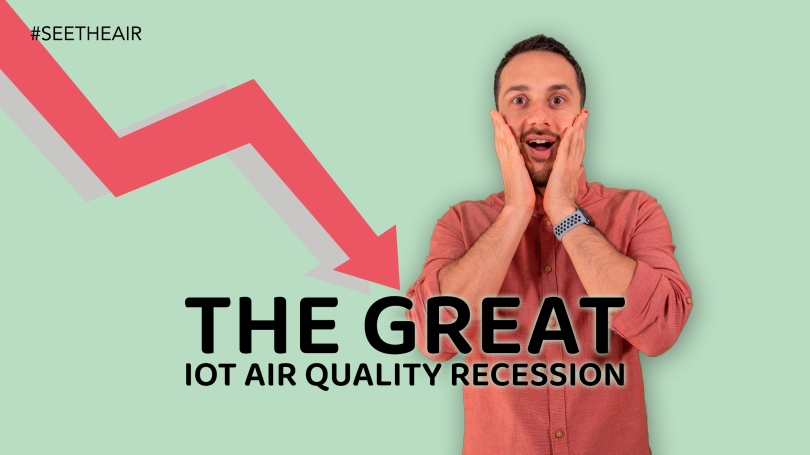The once booming Internet of Things (IoT) air quality monitoring market is facing a harsh reality check. Fueled by a surge in AI startups attracting investments and a subsequent saturation of low-cost air quality monitors, the industry is experiencing a period of upheaval. This downturn, dubbed “The Great IoT Air Quality Recession,” is forcing companies to adapt or face extinction. I see many high-profile executives leaving previously thought innovative startups in the realm of air quality in search of a more “stable” future.
A Wave of Investment and Sensor Saturation
AI startups like ChatGTP and similar, promising to leverage the power of machine learning to generate content or analyze data, became investor darlings. This new influx of cash is fueling the decline of IoT low-cost air quality solutions.
After the COVID-19 pandemic, the market quickly became saturated with low-cost monitors that promised that will fix indoor and outdoor environments. Buildings were filled with cheap monitors, but actionable insights remained scarce. The promised AI-powered analysis, in many cases, failed to materialize. Consumers were left with a plethora of data points with no clear understanding of what it all meant or what to do.
A Movement for Change
This lack of meaningful solutions has led to a movement for change within the industry. Consumers are demanding more than just data. They want actionable insights, personalized recommendations, and integration with smart home devices like Air Purifiers/Building Automation Systems/etc.
Companies are taking notice. The focus is shifting from simply collecting data to providing a holistic air quality management experience. This includes:
- Developing user-friendly interfaces: Data needs to be presented in a clear and concise way, allowing users to easily understand air quality levels and trends.
- Actionable recommendations: The system should suggest solutions based on the data, such as suggesting when to open windows, activate air purifiers, and many more.
- Integration with smart home devices: Air quality monitors should seamlessly connect with other smart home devices to automatically improve indoor air quality.
- Standardized Sensors: Unfortunately, low-cost sensors don’t comply to any standards nor comply to calibration specification. The industry needs to adopt new sensor technologies that are able to provide traceability.
The Road Ahead
The Great IoT Air Quality Recession is a wake-up call for the industry. Companies that can adapt to the changing consumer demands and deliver a truly valuable air quality management solution will emerge stronger. Those who cling to the old model of simply selling data are likely to be left behind.
The future of the IoT air quality market lies in providing actionable insights and a connected ecosystem that empowers consumers to take control of their air quality. Additionally, calibratable sensors that comply to actual standards will make the difference. Only then can the industry truly fulfill its potential and deliver on the promise of cleaner, healthier air for everyone.
P.S. Not only IoT air quality integrators (integrators refers to companies that integrate sensors in one air quality monitor/device) are facing this recession, but also green building certification organizations.
Discover more from See The Air
Subscribe to get the latest posts to your email.


Great article and insights – thank you
Another issue effecting adoption of more economic measuring systems is a blind spot and lack of focus on quality of measurement. The discussion is frequently on low cost sensors rather than what data quality is required for different measurement decisions and supporting standards and accreditations.
In the field of ambient PM2.5 and PM -10 measurement, there is a need to update the indicative MCERTS performance standards to ensure external dust measurements include heated inlets to avoidable errors on foggy mornings
A relevant MCERTS standard for local authority NO2 measurement is also required to ensure hyperlocal instruments have a correlation vs reference methods which is maintainable over the period between calibrations (years) and not just when new
Users and manufacturers need standards and ‘hooks’ to support quality, both in terms of instrument performance and the ownership and calibration of such instruments =it would help the evolution of the IOT air quality market
LikeLiked by 1 person
Whilst we keep changing tack, we are going to get to the end point of clean air much slower.
What’s happened to the old science that says, ‘Outdoor air effects indoor air?’
How many people have died because of indoor air? Not too many I wouldn’t imagine unless it was polluted air that came in from outside.
There seems to be this push to have people locked up inside so deliberate burning can continue. People need to stop burning stuff.
Let’s put our effort into cleaning up our outdoor air then we won’t need all these gadgets to try and keep us alive inside.
We must get rid of all the different Air Quality Indexes (AQIs) and different health-based standards around the world. Tasmania doesn’t have AQI and we have some of the cleanest air in the world with our lowest health-based standards.
Universal clean healthy outdoor air is what we want.
LikeLike